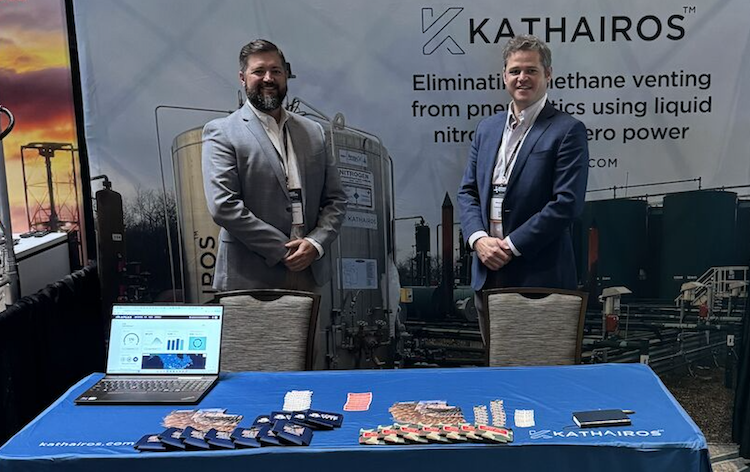
Kathairos has emerged as the leading North American solution for methane elimination from pneumatics, with more than 2,400 systems in operation across North America and over 70 major oil and gas producer partners.
In this post
Oil and gas operations rely on complex systems to extract, transport, and refine resources. One of the key components that provide power to these systems are pneumatics, which use compressed air to drive machinery and perform crucial tasks.
Pneumatics 101
Before we dive into the specifics of pneumatics in the oil and gas industry, it's important to have an understanding of what pneumatics are.
In a nutshell, pneumatics are a branch of engineering that use compressed air to generate mechanical motion, much like how compressed gas powers a piston, which then drives a machine or performs a specific task.
Pneumatic systems are useful in a number of different industries, but the oil and gas sector is a particularly important one due to the unique challenges that it faces.
Tasks such as drilling, pipeline maintenance, and platform operations require heavy machinery that need reliable, high-power sources of energy. For that, pneumatics fits the bill perfectly.
Applications in Industry
Pneumatics has a wide range of applications in the oil and gas industry. One of the most common is for drilling operations, where compressed air is used to power the drilling bit and rotate the drill string.
This can be especially useful in offshore drilling operations, where water is used as a lubricant and hydraulic systems may not provide enough power.
Another important application is in pipeline maintenance. Pneumatic systems can be used to test pipelines for leaks by creating a pressure differential within the pipeline. Similarly, they can be used to purge pipelines of residual liquids and gases, ensuring that they are safe to work on.
Pneumatic systems are also used in platform operations, where they power equipment such as cranes, hoists, and winches. These systems provide the high-power output required to lift heavy loads and move equipment around the platform.
Well sites also use pneumatics to actuate pumps, controllers, and devices. These operations, which routinely use fuel gas, are a significant source of methane emissions from the oil and gas industry, and are a large focus of current emissions reduction efforts.
Challenges and Opportunities in Pneumatics
While pneumatics are a crucial technology in the oil and gas industry, they’re not without certain challenges.
One of the biggest is the sheer amount of compressed air required to power these systems. Oil and gas operations are incredibly energy-intensive, and the need for compressed air can be a significant contributor to overall energy consumption.
Traditionally, opportunities to improve the efficiency of pneumatic systems included investing in energy-efficient compressors that require less power to operate, or exploring ways to recycle the compressed air used in these systems, reducing waste and improving overall energy efficiency.
Regulatory pressures, ambitious reduction targets, and the need for more effective solutions have also led to several technological innovations to address problems with pneumatic systems.
For example, the Kathairos solution replaces the fuel gas typically used to power pneumatic pumps and controllers at remote locations with high-pressure nitrogen gas, which is an inert, non-flammable, and non-polluting alternative to methane.
The Takeaway
Pneumatics are an essential technology in the oil and gas industry, powering everything from drilling, pipeline maintenance, well site operations, and beyond.
While it's not without its challenges, particularly when it comes to energy consumption, there are opportunities to improve efficiency and reduce waste. Additionally, technological innovations continue to transform existing practices, and drive industry towards decarbonization.
As the industry continues to evolve, pneumatics will likely remain an important technology for powering vital operations.
Explore more posts from Kathairos

RSVP: North America’s Best Energy, Oil & Gas Conferences and Events in 2026
.png)
What You Need to Know About Canada’s Final Methane Regulations—and How They Align with the Alberta MOU

